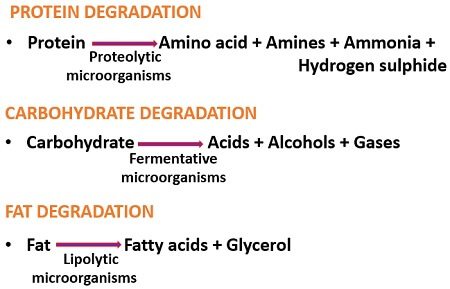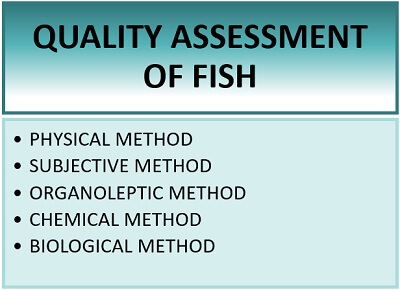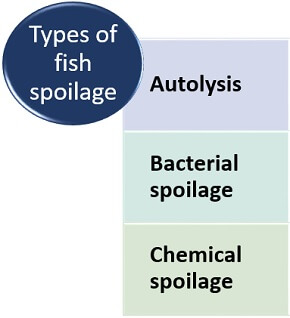Spoilage of fish is a process of deterioration in the quality of fish, which changes its appearance, odour and taste. The breakdown of biomolecules like proteins, amino acids and fats in the fish are the factors responsible for fish spoilage. Thus, a fish can be spoiled by either chemical or biological degradation.
In chemical degradation, protein, fats, amino acids etc., are decomposed, whereas microorganisms carry out the biological degradation. Other than bacterial and chemical degradation, enzymatic and mechanical damage can also cause fish spoilage. There are certain factors like high moisture, protein and fat content, improper handling etc., that favouring the spoilage in fish.
The common causes of fish spoilage are bacterial contamination and chemical oxidation (protein, fats etc.). The microorganisms involved in fish spoilage refer to the SSOs (specific spoilage organisms) that result in the formation of numerous unwanted metabolites, which adds undesirable appearance, flavour, and odour to the fish.
SSOs’ growth strongly depends upon the nutritional components of fish, moisture content, high temperature etc. You will get to know the definition, causes, types, and assessment of fish spoilage in this context.
Content: Spoilage of Fish
Definition of Fish Spoilage
It refers to the contamination of fish, resulting in an undesirable change in the colour, texture, flavour, odour, appearance, etc. Spoilage of fish is also called “Putrefaction”. Fish spoilage can occur due to enzymatic degradation, bacterial degradation, chemical decomposition and mechanical damage. We can characterize the spoiled fish by observing the colour change, fishy smell, sliminess in the skin and scales, firmness of the flesh, discolouration of the backbone etc.
Causes
The action of microbes, enzymatic activity and oxidation of nutritive elements present in the fish are the common causes of fish spoilage. In addition to these, some other factors are also responsible like:
- Improper handling
- The high moisture content of the fish
- Weak muscle tissue
- Ambient temperature
Types
Fish spoilage is generally of three types, namely autolysis, bacterial and chemical spoilage.
Autolysis
It refers to enzymatic degradation that results in the cell damage of fish and release of an autolytic enzyme, which degrades the cell components like proteins, fats etc. and thereby changes the flavour of fish. The changes in the flavour of fish can be due to the conversion of ATP to hypoxanthine and the decomposition of fish.
- Conversion of ATP to hypoxanthine: This conversion adds a bitter taste, and we can estimate the degree of freshness by knowing the hypoxanthine content.
- Decomposition of fish: It leads to belly bursting of the fish, and the action of digestive enzymes in the fish gut is the cause of fish spoilage.
Autolysis can change the appearance and odour of the fish by two ways:
- Cause black spot formation: Autolysis can cause black spot formation in some shrimps by showing some enzymatic action on the amino acids. The black spot occurs due to the formation of melanin pigment, which results in poor appearance.
- Cause foul smell: Autolysis can produce a foul smell by the proteinase enzyme degradation of muscle proteins into amino acids and other compounds like ammonia, carbon dioxide, amines, fatty acids etc. Thus, the production of secondary metabolites produces indole, skatole, etc., results in the release of a foul smell from a fish.
Bacterial Spoilage
A fish acquires a load of bacteria in the gills and on the surface. When a fish dies, the bacteria already present in the fish attack the flesh and result in the formation of undesirable products. The microbial growth in fish depends on the type of water from where it caught. The bacteria cause fish spoilage by the following means:
- Reducing TMAO to TMA: Reduction of trimethylamine oxide into trimethylamine produces an offensive odour.
- Degradation of amino acid to primary amines: It can cause food poisoning.
- Example:
- Histidine – Histamine
- Glutamic-acid – Arginine
- Degradation of urea to ammonia: It also produces an offensive odour.
Chemical Spoilage
High temperature favours chemical spoilage. Oxidative rancidity is a common cause of chemical degradation.

Proteins split into amino acids, amines, ammonia and hydrogen sulphide by the action of proteolytic microorganisms. Carbohydrates split into acids, alcohols and gases by the action of fermentative microorganisms. Fats degrade split into fatty acids and glycerol by the action of lipolytic microorganisms.
Assessment of Fish Spoilage
We can access the quality of fish by the three consecutive methods:

Physical Method
Torrymeter is a device placed vertically, and it provides a digital reading of the fish quality, whether it is aged or fresh. From the digital readings or values of the torrymeter, we can estimate the fish freshness.
A low value indicates the presence of more bacterial mass. 10 is the highest value for the freshly caught fish, and below 3 is the value of spoiled fish. The value of 6 on the torrymeter is acceptable by the consumer.
Subjective Method
It is a sensory method assessed by the sensory organs, which represent the customer view.
Organoleptic Test
It includes the quality assessment of fish by the sense of sight, smell, touch etc.
We can check the quality of fish by using our sense of sight to examine the fish’s eyes, gills, and skin surface.
- The eyes should be clear and vibrant. Any discolouration around the eyes and cloudiness in the eyes indicates that the fish is not fresh.
- The gills should be red-pink in colour.
- The skin should be shiny, not slimy.
- The skin or the surface of fish should be clear, and there must not be any discolouration.
We can also check the quality of the fish by using our sense of touch to examine the flesh and scales of the fish:
- The flesh should be tight, elastic, but not slimy.
- The scales should be intact with the skin.
We can also check the quality of the fish by using our sense of smell:
- The smell of fish should be neutral and fresh.
- There should not be a fishy, sour or ammonia-like smell.
Biochemical Method
It includes the following methods:
- Proximate testing: It is a prevalent method in which the fish components like moisture, protein, lipid etc., are regularly checked from the time of fish harvesting. This method does not give a satisfactory assessment and thereby not accepted widely.
- Hypoxanthine value: After the death of fish, ATP (Adenosine triphosphate) splits into ADP, AMP, IMP and finally into hypoxanthine. The value of hypoxanthine increases during the storage of fish. Hypoxanthine value gives an estimate for the freshness of fish. A fish is considered to be spoiled if a hypoxanthine value reaches 7-8 micromoles/g.
- Trimethylamine (TMA) value: Fish contains a considerable amount of trimethylamine oxide (TMAO), but on fish spoilage, TMAO reduces into TMA. The value of TMA with a level of 1.5 mg / 100 g indicates that the fish is moderately spoilt.
- Ammonia production: The production of ammonia indicates the extent of spoilage.
- Peroxidase value: It helps in the measurement of oxygen rancidity. Peroxidase value less than 10 (indicates the good quality of fish) and a value more than 20 (indicates rancidity).
- Thiobarbituric acid value (TBA): It also helps us to determine the oxygen rancidity. TBA value less than 2, is accepted by the consumer.
Biological Method
It includes the total plate count method (TPC). The biological method involves a quality assessment of fish by the bacterial cell count. First, you need to grind the fish and then dilute the sample by following serial dilution. Prepare media for the growth of microorganisms present in the fish, where we can use both ordinary and selective media.
We can use agar media to enumerate the microbial mass in marine fish and tryptone glucose beef extract agar media to calculate the cell count in processed fish. Other than this, selective media like SS-agar can be used for the detection of coliform bacteria (E.coli, Shigella sp, etc.) in the fish. After media preparation, perform the pouring method and incubate the plates for 24 hours at 35-37 degrees Celsius.
Count the number of bacteria per plate by multiplying with the dilution factor. Thus, the total plate count method gives a count for the bacterial (pathogenic and non-pathogenic) population present in the fish. Hence, the total plate count method does not determine the edibility of the fish.

Dear Madam, It’s a nice presentation.
BEST OF ALL
Thanks for the accurate answers.
Thank you for the great information.
Is there an agents of spoilage?
Spoilage is mainly through the invasion of food items by microbial agents like bacteria and fungi. Secondly, food spoilage can be caused due to the chemical oxidation of the protein and fat content of the food.